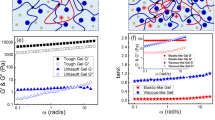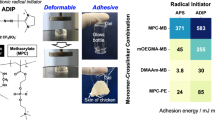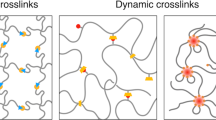Abstract
This research showed that the self-healing properties of reversible crosslinked gels with host–guest inclusion complexes depended on the mobility of network chains and the recombination behaviors of reversible complexes, which were affected by changes in the water–glycerol solvent composition. The sticky reptation behaviors of the polymer chains were delayed by the recombination behaviors of reversible bonds. These behavioral characteristics were observed based on a dynamic viscoelasticity. Increasing the glycerol concentration in the mixed solvent decreased the surface tension and increased the mobility of the network chains because the recombination of the complex was slowed by the weak hydrophobic interactions between the host and guest molecules. Consequently, self-healing properties, such as re-adhesion at the cutting surface, were improved by the interdiffusion of polymer chains at the reattached interface. The strong hydrophobic interactions in pure water promoted the formation of complexes within the same cutting surface, thus decreasing the self-healing rates of the mechanical properties. In this study, the solvent was found to be an important parameter for controlling the self-healing properties of reversible crosslinked gels. The competition between the mobility of polymer chains and the recombination behaviors of reversible bonds controlled the self-healing properties of the gels with host–guest inclusion complexes.
This is a preview of subscription content, access via your institution
Access options
Subscribe to this journal
Receive 12 print issues and online access
$259.00 per year
only $21.58 per issue
Buy this article
- Purchase on SpringerLink
- Instant access to full article PDF
Prices may be subject to local taxes which are calculated during checkout





Similar content being viewed by others
References
Kato T, Gupta M, Yamaguchi D, Gan KP, Nakayama M. Supramolecular association and nanostructure formation of liquid crystals and polymers for new functional materials. Bull Chem Soc Jpn. 2021;94:357–76.
Wang S, Urban MW. Self-healing polymers. Nat Rev Mater. 2020;5:562–83.
Li B, Cao P-F, Saito T, Sokolov AP. Intrinsically self-healing polymers: from mechanistic insight to current challenges. Chem Rev. 2023;123:701–35.
Sinawang G, Osaki M, Takashima Y, Yamaguchi H, Harada A. Supramolecular self-healing materials from non-covalent cross-linking host–guest interactions. Chem Commun. 2020;56:4381–95.
Noro A, Hayashi M, Matsushita Y. Design and properties of supramolecular polymer gels. Soft Matter. 2012;8:6416–29.
Kim C, Yoshie N. Polymers healed autonomously and with the assistance of ubiquitous stimuli: how can we combine mechanical strength and a healing ability in polymers? Polym J. 2018;50:919–29.
Kobayashi Y. Precise synthesis of polyrotaxane and preparation of supramolecular materials based on its mobility. Polym J. 2021;53:505–13.
Kawai Y, Park J, Ishii Y, Urakawa O, Murayama S, Ikura R, et al. Preparation of dual-cross network polymers by the knitting method and evaluation of their mechanical properties. NPG Asia Mater. 2022;14:32.
Chen X, Dam MA, Ono K, Mal A, Shen H, Nutt SR, et al. A thermally re-mendable cross-linked polymeric material. Science. 2002;295:1698–702.
Montarnal D, Capelot M, Tournilhac F, Leibler L. Silica-like malleable materials from permanent organic networks. Science. 2011;334:965–8.
Otsuka H. Reorganization of polymer structures based on dynamic covalent chemistry: polymer reactions by dynamic covalent exchanges of alkoxyamine units. Polym J. 2013;45:879–91.
Hayashi M, Oba Y, Kimura T, Takasu A. Simple preparation, properties, and functions of vitrimer-like polyacrylate elastomers using trans-n-alkylation bond exchange. Polym J. 2021;53:835–40.
Guo M, Pitet LM, Wyss HM, Vos M, Dankers PYW, Meijer EW. Tough stimuli-responsive supramolecular hydrogels with hydrogen-bonding network junctions. J Am Chem Soc. 2014;136:6969–77.
Yanagisawa Y, Nan Y, Okuro K, Aida T. Mechanically robust, readily repairable polymers via tailored noncovalent cross-linking. Science. 2018;359:72–6.
Li Z, Zhu Y-L, Niu W, Yang X, Jiang Z, Lu Z-Y, et al. Healable and recyclable elastomers with record-high mechanical robustness, unprecedented crack tolerance, and superhigh elastic restorability. Adv Mater. 2021;33:2101498.
Kuo D, Sakamoto T, Torii S, Liu M, Katayama H, Kato T. Removal of viruses from their cocktail solution by liquid-crystalline water-treatment membranes. Polym J. 2022;54:821–5.
Uchida J, Yoshio M, Kato T. Self-Healing and shape memory functions exhibited by supramolecular liquid-crystalline networks formed by combination of hydrogen bonding interactions and coordination bonding. Chem Sci. 2021;12:6091–8.
Li C-H, Wang C, Keplinger C, Zuo J-L, Jin L, Sun Y, et al. A highly stretchable autonomous self-healing elastomer. Nat Chem. 2016;8:618–24.
Filippidi E, Cristiani TR, Eisenbach CD, Waite JH, Israelachvili JN, Ahn BK, et al. Toughening elastomers using mussel-inspired iron-catechol complexes. Science. 2017;358:502–5.
Miwa Y, Taira K, Kurachi J, Udagawa T, Kutsumizu S. A gas-plastic elastomer that quickly self-heals damage with the aid of Co2 gas. Nat Commun. 2019;10:1828.
Brézault A, Perrin P, Sanson N. Multiresponsive supramolecular Poly(N-Isopropylacrylamide) microgels. Macromolecules. 2024;57:2651–60.
Takahashi R, Udagawa T, Hashimoto K, Kutsumizu S, Miwa Y. Effect of the Mg2+ ratio on the mechanical and self-healing properties of polyisoprene ionomers co-neutralized with Na+ and Mg2 + . Polym J. 2024;56:699-704.
Scott Lokey R, Iverson BL. Synthetic molecules that fold into a pleated secondary structure in solution. Nature. 1995;375:303–5.
Wang W, Li L-S, Helms G, Zhou H-H, Li ADQ. To Fold or to Assemble. ? J Am Chem Soc. 2003;125:1120–1.
Burattini S, Colquhoun HM, Fox JD, Friedmann D, Greenland BW, Harris PJF, et al. A self-repairing, supramolecular polymer system: healability as a consequence of donor–acceptor π–π stacking interactions. Chem Commun. 2009;28:6717–9.
Urban MW, Davydovich D, Yang Y, Demir T, Zhang Y, Casabianca L. Key-and-lock commodity self-healing copolymers. Science. 2018;362:220–5.
Gaikwad S, Urban MW. Ring-and-lock interactions in self-healable styrenic copolymers. J Am Chem Soc. 2023;145:9693–9.
Lai H, Jin C, Park J, Ikura R, Takashima Y, Ouchi M. A transformable and bulky methacrylate monomer that enables the synthesis of an Mma-Nba alternating copolymer: sequence-dependent self-healing properties. Angew Chem Int Ed. 2023;62:e202218597.
Zhao Y, Yin R, Wu H, Wang Z, Zhai Y, Kim K, et al. Sequence-enhanced self-healing in “lock-and-key” copolymers. ACS Macro Lett. 2023;12:475–80.
Nghiem TT, Nguyen BL, Huyen LT, Kawahara S. A novel approach to prepare self-healing vulcanized natural rubber using tetramethylthiuram disulfide. Polym J. 2023;55:1097–1102.
Schmidt BVKJ, Barner-Kowollik C. Dynamic macromolecular material design—the versatility of cyclodextrin-based host–guest. Chem Angew Chem Int Ed. 2017;56:8350–69.
Takashima Y, Sawa Y, Iwaso K, Nakahata M, Yamaguchi H, Harada A. Supramolecular materials cross-linked by host–guest inclusion complexes: the effect of side chain molecules on mechanical properties. Macromolecules. 2017;50:3254–61.
Huang Z, Chen X, O’Neill SJK, Wu G, Whitaker DJ, Li J, et al. Highly compressible glass-like supramolecular polymer networks. Nat Mater. 2022;21:103–9.
Susa A, Bose RK, Grande AM, van der Zwaag S, Garcia SJ. Effect of the dianhydride/branched diamine ratio on the architecture and room temperature healing behavior of polyetherimides. ACS Appl Mater Interfaces. 2016;8:34068–79.
Yasuda Y, Nakagawa S, Houjou H, Yoshie N, Morita H. Coarse-grained molecular dynamics simulations of dynamic bond elastomers using interbead potentials for entropy- and enthalpy-driven mechanisms in their dynamics and mechanical properties. Macromolecules. 2023;56:7432–44.
Stadler R, De Lucca Freitas L. Relaxation behavior of linear polymer chains with statistically distributed functional groups. Macromolecules. 1989;22:714–9.
Leibler L, Rubinstein M, Colby RH. Dynamics of reversible networks. Macromolecules. 1991;24:4701–7.
Baxandall LG. Dynamics of reversibly crosslinked chains. Macromolecules. 1989;22:1982–8.
Hu X, Zhou J, Daniel WFM, Vatankhah-Varnoosfaderani M, Dobrynin AV, Sheiko SS. Dynamics of dual networks: strain rate and temperature effects in hydrogels with reversible h-bonds. Macromolecules. 2017;50:652–9.
Cao X, Yu X, Qin J, Chen Q. Reversible gelation of entangled ionomers. Macromolecules. 2019;52:8771–80.
Golkaram M, Loos K. A critical approach to polymer dynamics in supramolecular polymers. Macromolecules. 2019;52:9427–44.
Zhang R, Zhang C, Yang Z, Wu Q, Sun P, Wang X. Hierarchical dynamics in a transient polymer network cross-linked by orthogonal dynamic bonds. Macromolecules. 2020;53:5937–49.
Katashima T. Rheological studies on polymer networks with static and dynamic crosslinks. Polym J. 2021;53:1073–82.
Ahmadi M, Jangizehi A, Seiffert S. Backbone polarity tunes sticker clustering in hydrogen-bonded supramolecular polymer networks. Macromolecules. 2022;55:5514–26.
Cai PC, Su B, Zou L, Webber MJ, Heilshorn SC, Spakowitz AJ. Rheological characterization and theoretical modeling establish molecular design rules for tailored dynamically associating polymers. ACS Cent Sci. 2022;8:1318–27.
Martins ML, Zhao X, Demchuk Z, Luo J, Carden GP, Toleutay G, et al. Viscoelasticity of polymers with dynamic covalent bonds: concepts and misconceptions. Macromolecules. 2023;56:8688–96.
Xia J, Kalow JA, Olvera de la Cruz M. Structure, dynamics, and rheology of vitrimers. Macromolecules. 2023;56:8080–93.
Ge S, Samanta S, Li B, Carden GP, Cao P-F, Sokolov AP. Unravelling the mechanism of viscoelasticity in polymers with phase-separated dynamic bonds. ACS Nano. 2022;16:4746–55.
Carden P, Ge S, Zhao S, Li B, Samanta S, Sokolov AP. Influence of molecular architecture on the viscoelastic properties of polymers with phase-separated dynamic bonds. Macromolecules. 2023;56:5173–80.
Watase M, Nishinari K. Effects of the degree of saponification and concentration on the thermal and rheological properties of Poly(Vinyl Alcohol)-dimethyl sulfoxide-water gels. Polym J. 1989;21:567–75.
Ohkura M, Kanaya T, Kaji K. Gelation rates of Poly(Vinyl Alcohol) solution. Polymer. 1992;33:5044–8.
Hoshino H, Okada S, Urakawa H, Kajiwara K. Gelation of poly(vinyl alcohol) in dimethyl sulfoxide/water solvent. Polym Bull. 1996;37:237–44.
Kanaya T, Takahashi N, Takeshita H, Ohkura M, Nishida K, Kaji K. Structure and dynamics of Poly(Vinyl Alcohol) gels in mixtures of dimethyl sulfoxide and water. Polym J. 2012;44:83–94.
Mathis L, Chen Y, Shull KR. Tuning the viscoelasticity of hydrogen-bonded polymeric materials through solvent composition. Macromolecules. 2018;51:3975–82.
Costanzo S, Banc A, Louhichi A, Chauveau E, Wu B, Morel M-H, et al. Tailoring the viscoelasticity of polymer gels of gluten proteins through solvent quality. Macromolecules. 2020;53:9470–9.
Tanaka F. Thermoreversible gelation of associating polymers in hydrogen-bonding mixed solvents. Langmuir. 2022;38:5098–10.
Tanaka F. Thermoreversible gelation interfering with phase separation in multicomponent mixtures of associating polymers. Macromolecules. 2022;55:5233–48.
Nakahata M, Takashima Y, Harada A. Highly flexible, tough, and self-healing supramolecular polymeric materials using host–guest interaction. Macromol Rapid Commun. 2016;37:86–92.
Konishi S, Kashiwagi Y, Watanabe G, Osaki M, Katashima T, Urakawa O, et al. Design and mechanical properties of supramolecular polymeric materials based on host–guest interactions: the relation between relaxation time and fracture energy. Polym Chem. 2020;11:6811–20.
Fang L, Brown W, Hvidt S. Static and dynamic properties of polyacrylamide gels and solutions in mixtures of water and glycerol: a comparison of the application of mean-field and scaling theories. Macromolecules. 1992;25:3137–42.
Hopkins SD, Gogovi GK, Weisel E, Handler RA, Blaisten-Barojas E. Polyacrylamide in glycerol solutions from an atomistic perspective of the energetics, structure, and dynamics. AIP Adv. 2020;10:085011.
Segur JB, Oberstar HE. Viscosity of glycerol and its aqueous solutions. Ind Eng Chem. 1951;43:2117–20.
Winter HH, Chambon F. Analysis of linear viscoelasticity of a crosslinking polymer at the gel point. J Rheol. 1986;30:367–82.
Acknowledgements
This research was funded by Scientific Research on Innovative Areas JP19KK0131, JP19H05714 and JP19H05721 from the MEXT of Japan, JST; the Core Research for Evolutional Science and Technology (CREST) program JPMJCR22L4; the COI-NEXT program JPMJPF2218; the Asahi Glass Foundation; the Yazaki Memorial Foundation for Science; the Suzuki Foundation; and the Iketani Science and Technology Foundation, 0361034-A. The ITC measurement was performed at the Analytical Instrument Facility, Graduate School of Science, Osaka University.
Author information
Authors and Affiliations
Corresponding authors
Ethics declarations
Conflict of interest
The authors declare no competing interests.
Additional information
Publisher’s note Springer Nature remains neutral with regard to jurisdictional claims in published maps and institutional affiliations.
Supplementary information
Rights and permissions
Springer Nature or its licensor (e.g. a society or other partner) holds exclusive rights to this article under a publishing agreement with the author(s) or other rightsholder(s); author self-archiving of the accepted manuscript version of this article is solely governed by the terms of such publishing agreement and applicable law.
About this article
Cite this article
Yamaoka, K., Ikura, R., Osaki, M. et al. Viscoelastic behaviors for optimizing self-healing of gels with host–guest inclusion complexes. Polym J 56, 1031–1039 (2024). https://doi.org/10.1038/s41428-024-00932-7
Published:
Issue date:
DOI: https://doi.org/10.1038/s41428-024-00932-7



